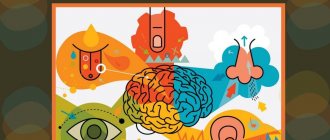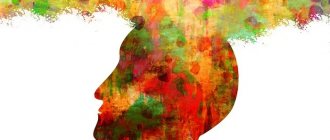Definition of the concept of “consciousness” in psychology
Consciousness in psychology is a set of interconnected information reflected in a person’s memory about the surrounding world and human life, which also includes the awareness of the person himself in this world and his attitude towards society, people and the whole world as a whole.
Consciousness is formed in the process of human interaction with the environment, as well as in the process of learning and communicating with people.
The processes of the human body through which consciousness is formed can be called the following processes:
- sensation;
- perception;
- thinking;
- imagination;
- memorization.
If any of the above processes are disrupted, this can lead to various disruptions in the functioning of consciousness and its disorders. A person, unlike an animal, can be aware of himself and also engage in self-knowledge.
Thanks to the presence of his “I” in the consciousness, a person can set goals dictated not only by instincts and physiological needs (as is the case with animals), but also goals formed thanks to individual, abstract thinking based on social, scientific and everyday knowledge.
Adequacy
Feelings are considered adequate if they correspond to the current situation. Because people want to fit into society and be considered normal, they constantly work on their feelings to fit the situation. Emotional labor is more about how people want to feel or how they want other people to see them. Feelings are not permanent, but continue because people constantly try to educate, suppress or manage them.
Functions of consciousness and properties
Consciousness performs the most important functions in human life. With the help of consciousness and the interaction of its constituent structures, a person analyzes the information received from the outside, evaluates it and processes this information to make all kinds of decisions in the process of life.
Consciousness has the following functions:
- Cognitive (consciousness is capable of not only subjectively reflecting the world around us, but also cognizing it through the analysis of accumulated information and knowledge gained as a result of the life of both an individual and all previous generations).
- Goal-setting (based on the material and spiritual needs of a person, consciousness has the ability to set goals that contribute to the development of the person himself, as well as the transformation of the external world).
- Axiological (a person can evaluate what is happening around him, as well as the activities of other people through the prism of his beliefs and needs that exist in his mind).
- Creative (a person is able not only to understand the world around him, but also to create new material and social benefits that develop and improve his life).
- Reflexive (the ability to analyze oneself and the content of one’s own consciousness).
- Spiritual (formation of the worldview and attitude of the individual to the social sphere of life).
Activity
Consciousness functions in constant activity (even in sleep it continues to work, partially processing information received during the day).
This activity implies not only the physical characteristics of the organism, but also the constant movement of mental, goal-setting activity of consciousness, aimed at achieving certain goals related to human activity, the transformation of his personality and the external world.
Intentionality
The main property of consciousness is its ability to be directed at a specific object in the process of mental activity. Thanks to the constant interaction of a person’s own “I” with individual elements of consciousness, the process of its development and the fulfillment of all existing functions of consciousness occur.
Structure
There are 3 levels of knowledge. A person has a lower level since childhood, which increases with age. If this does not happen, the individual remains with a lower level of consciousness. He perceives the world like a child and is incapable of building normal relationships.
Each level has its own typical features:
- High level. A person who has reached the highest form of development is characterized by strong intuition, high intelligence, objectivity, and developed analytical thinking. The speed of development depends on external circumstances and activities. Individuals engaged in intellectual work develop faster. They are more prone to reflection and in-depth analysis of phenomena. Development occurs faster for people working in the creative field. Developed intuition is a necessary quality for successful activities. Such people, already at an early age, differ from their peers in that they cope faster with learning new information and solving complex problems. Such people make up no more than 15% of the total number.
- Average level. It is common to most people. This level of consciousness is enough to satisfy life's needs. People with an average level of development are busy solving only their own problems. They are not interested in philosophical questions; their level of intelligence and awareness does not allow them to operate with such categories of knowledge.
- Low level. Occurs in 20–25% of people over 18 years of age. Such people are considered ignorant and intellectually undeveloped. They are not interested in self-development. All interests are aimed at achieving pleasure without assessing the consequences of their actions. People with a low level of development have primitive thinking, which is usually characteristic of preschool children.
Cognition is dynamic. If desired, an individual can independently develop it and reach a high level. The older he gets, the more difficult it is to rebuild the process of studying the world and stimulate its development.
Forms and types
Consciousness in psychology is a dual concept that can mean such forms of consciousness as social and individual consciousness.
Social consciousness is the totality of knowledge, ideas and views inherent in a particular society or all of humanity at a certain stage of its development.
Structure of consciousness in psychology
Individual consciousness is the totality of knowledge, ideas and views of an individual.
Both forms of consciousness influence each other throughout their entire existence. As a result of this interaction, the development of both social and individual consciousness of all people occurs.
Depending on the degree of clarity of individual consciousness, several types are distinguished:
- Clear (when a person thinks actively, answers questions clearly and reacts adequately to surrounding events).
- Unclear (when a person shows indifference towards himself, and he answers the questions posed slowly and not always correctly).
- Stupor (if a person cannot independently navigate in space and reacts slowly to external stimuli).
- Dullness (if a person is almost always in hibernation, from which he can only be brought out for a short time).
- Coma (when a person is in deep sleep and does not react to anything).
- Delusion (when a person perceives reality in a distorted form and reacts inadequately to external events).
- Hallucinations (if a person experiences auditory or visual distortions of information perceived from outside).
Connection with the unconscious
Consciousness can influence information processing processes that occur in the unconscious. They are not subject to logic, but have more power. The unconscious helps solve creative problems. The beginning of problem analysis is spontaneous. When enough information accumulates in the subconscious, its processing begins. As a result, a decision appears that moves from the area of the unconscious to the area of consciousness. This process can be regarded as a manifestation of intuition.
Some types of problems are solved at a conscious and unconscious level. How exactly the task moves from the lower spheres of the psyche to the higher, psychologists do not know. According to the theory of Ya. Ponomarev, this is an ancient mechanism that was formed evolutionarily. The connection with the unconscious component is inextricable. In a normal state, a person cannot determine which decision came from the subconscious and which was formed in the higher part of the psyche.
If the unconscious is not under control, the individual loses the ability to regulate his behavior. All hidden, base desires become dominant. The personality loses social skills, its development rolls back to the level of a two-year-old child. He is selfish, incapable of compromise, and often becomes dangerous.
Levels of Consciousness
In the process of human evolution, his consciousness also develops. A person’s attitude towards people and the world around him directly depends on the degree of development of his consciousness. As a result of many years of research into human consciousness, the famous psychologist David Hawkins identified 18 levels at which a person’s consciousness can be located, and each of these levels determines the degree of development of a person’s consciousness.
- Despair and shame (when a person, being a fool and making many mistakes because of this, often becomes depressed and hates everything around him, including himself).
- Feelings of guilt (when a person cannot forgive himself for past negative actions).
- Apathy (when a person loses interest in life, as a result of which he avoids any responsibility and may fall into dependent relationships).
- Grief (if a person falls into a state of constant regret and depression as a result of any failures or losses in life).
- Fear (when a person perceives the surrounding reality as too dangerous, resulting in a suppression of interest in life).
- Desires (if a person considers the meaning of life to be the satisfaction of his passions and excessively strives for material wealth).
- Anger (this state of consciousness arises from dissatisfaction with the desires of the previous level, as a result of which such a person can constantly be irritated and quarrel with others).
- Pride (this state of consciousness occurs when some success is achieved, as a result of which a person excessively increases his self-esteem and begins to divide people into friends and foes, thinking that he is superior to others).
- Courage (when a person has the courage and determination to overcome obstacles on the way to achieve new successes).
- Neutrality (when a person gains moral independence from other people and external circumstances, as a result of which he begins to be loyal to the people and events around him, even if they somehow try to influence him).
- Willingness (when a person’s goal is not material wealth, but the development of internal harmony, will and discipline, as a result of which a person becomes more sincere and friendly).
- Acceptance (a person’s awareness that the source of happiness and love is within himself, as a result of which a person stops demanding or expecting anything from others, and he himself begins to give people positive emotions, and stops judging others).
- Intelligence (when a person begins life primarily with the mind, and emotions take a back seat).
- Love (when a person realizes that love is higher than reason, as a result a person begins to act not from logical reasoning, but from a sincere state of love).
- Joy and unconditional love (when a person's love expands to an all-encompassing love for the world, nature and all people).
- Harmony, bliss (when a person is in a state of unity with the world and the boundaries between subject and object are erased, as a result of which a person feels himself to be one with nature and the universe).
- Awareness of “I” (the level of consciousness at which individual experiences disappear, and a person’s thoughts become transcendental at the level of the universe).
- Complete enlightenment (the highest state of consciousness, when a person’s consciousness completely merges with the divine principle and a person becomes a part of it).
At the highest level of consciousness were figures such as Buddha, Jesus and perhaps some great sages (Advaitas or Vedantas).
HER. Sokolova. Consciousness as reality (definitions and properties of consciousness) Added by Psychology OnLine.Net 05/14/2009 (Edit 05/14/2009) In section 2, we traced the history of the emergence of the problem of consciousness in psychology and examined individual options for its solution (in particular, in introspective psychology, in Gestalt psychology , at the school of L. S. Vygotsky, etc.). In this chapter, based on this analysis, we will give a generalized idea of consciousness as a reality and the possibilities of its study in scientific psychology. Before moving on to the presentation, let us emphasize one important circumstance. Very often in philosophical and psychological literature the term “consciousness” is used to refer to the human psyche in general. We do not share this point of view. Consciousness is the highest form of mental reflection of the world, not only in relation to the animal psyche, but also in relation to other forms of mental reflection in humans. When a newborn child begins to navigate the world around him, he undoubtedly does not yet have consciousness, which is formed in him in ontogenesis in joint activity with an adult on the basis of other - preconscious - forms of the human psyche (at the same time, from the very beginning, human mental development is socially conditioned ). Therefore, the attempts of S. Freud and other psychologists to identify a number of levels in the human psyche - consciousness, preconscious and unconscious - were quite legitimate. In addition, the concepts of “consciousness” and “awareness” should not be confused. Not everything that even at this moment enters into my conscious image of the world is conscious. Awareness means that at this moment in my life I am aware of, say, the sentence that I am now writing, or that I am now locking a door that has a very complex and difficult lock. However, at the same time, my conscious image of the world contains many conscious contents. When I lock the door, I, for example, do not realize what my neighbor, who has come out of her apartment and is standing in the corridor, is telling me, although when the conditions of activity change, I can always realize this. Thus, the scope of the concept of “consciousness” includes what S. Freud called consciousness itself, and what he also called preconscious (preconscious is something that is not conscious at the moment, but can potentially be conscious), i.e. not everything conscious is conscious. Moreover, in the very result of the act of awareness, it is necessary to distinguish at least two (possibly more) levels of awareness (V. Wundt called them “consciousness” and “attention”). Distinguishing the concepts of “consciousness” and “awareness”, we will nevertheless more often use the term “consciousness”, since this term is more established and is used in psychology both to designate what is actually conscious and to designate those states that are not currently are conscious, but can potentially become conscious as soon as the need arises. Let us now turn to the phenomenology of consciousness, i.e. to a description of its properties and phenomena that are revealed to us through introspection. In the history of psychological science, these phenomena, in fact, were identified with consciousness (the essence and the phenomenon, from the point of view of introspectionist psychologists, coincide), and the method of studying the latter was considered introspection as the only method of penetration into the inner world (the world of consciousness). Without sharing this point of view, we will nevertheless present the results of studies of consciousness in various psychological directions, including introspectionism. “In its immediacy,” wrote A.N. Leontiev, “consciousness is the picture of the world that opens to the subject, in which he himself, his actions and states are included” [62, 125]. A conscious subject shares a more or less clearly objective world, on the one hand, and a subjective image (“picture”) of the world, on the other, while a subject characterized by other ways of mentally reflecting the world, or a person who does not think about such complex issues (“non-reflective subject,” as A. N. Leontiev called him), does not separate the world and the image of this world in his experience. This is, for example, the perception of the world by animals with a psyche. If in special experiments animals (great apes) were put on special glasses that turned the visual display of the world 180 degrees, for the animals the world was turned upside down, not its image - the animal went into shock and could not move. If a similar operation is performed on a person, as was done at the end of the 19th century. J.M. Stratton, then a person initially experiences some difficulties in the process of orientation in the world, which is now presented to him somewhat differently, but then he more or less successfully begins to cope with the situation, rightly believing that the same objective world is now simply presented (presented) differently in his subjective picture of the world. Many psychologists (L.S. Vygotsky, A.N. Leontiev and others) believe that thanks to a person’s special way of life, the characteristics of his activities, his command of language, in which the world is presented to the subject in its essential properties “ideally”, a person (and only man) is able to relate to the world (K. Marx also wrote that the animal does not relate to anything, its environment is not for it a world opposing it, the animal is not isolated from the world). And it is man, as D.A. Leontiev writes, who is “the only one of all living beings to whom the world is given as a single coherent whole, extending in space and time beyond the limits of the current situation and at the same time lying or facing the subject, and not just his surroundings” [69, 116]. In our consciousness, the world is presented in the form of an image of the world, which we can separate from the world itself, that is, we can realize that there is an objective world and there is my mental activity, which proceeds according to its own laws. The consequences of this separation in the consciousness of the world and its image are: 1) a more objective (compared to preconscious forms of mental reflection) comprehension of the world. This means in this case the following: despite the fact that human consciousness, like the human psyche in general, is determined by need-motivational structures and in this sense is biased, however, unlike the psyche of animals, a conscious person is capable of reflecting such properties of reality, which may contradict his desires and inclinations (whether I like it or not, this is the truth; the world is terrible, but these are its laws, etc.). A person has the opportunity to look at the world not only from his own, but also from “someone else’s” point of view; 2) the ability to be aware of one’s own mental processes, i.e. monitor their progress, intervene in them if necessary and arbitrarily regulate them in accordance with the set plans and objectives. Thus, a person can, in a certain sense, “look from the outside” at his own mental activity and treat it more or less objectively. Moreover, in ontogenesis, as consciousness arises, the first appears earlier than the second. J. Locke once wrote about this (reflection as “internal experience” in a child develops later than “external experience”). A. N. Leontiev pointed out that awareness of an object arises before awareness of activity1. However, consciousness is not limited to the conscious image (picture) of the world, which often seems to the subject to be a simultaneous formation. Consciousness is also a time-lasting (successive) process. At the same time, consciousness as a process should not be understood as simply a process of replacing some images with others that occurs over time; consciousness as a process should be understood as an integral system of acts that solve their problems and act as functional organs of human activity. Both sides (hypostases) of consciousness (image and process) were described in introspective psychology. Within this direction in psychology, there were two alternative approaches to the study of consciousness: in structuralism, consciousness was studied as an image, while in functionalism, it was studied as a process. Accordingly, different properties of consciousness were identified and its various models and metaphors were proposed. W. Wundt considered consciousness as a “field”, within which an area of attention was also distinguished, i.e. clear and distinct consciousness. The creator of structuralism, E. B. Titchener, represented consciousness in the form of a certain “wave,” but this did not mean his transition in understanding consciousness to a different position—functionalism. He believed that over a certain period of time in consciousness, some of its contents rise to the level of clear consciousness, while others, on the contrary, fall to the level of vague consciousness. The properties of consciousness highlighted here were related specifically to consciousness as an image. In the concept of W. James, one of the creators of American functionalism, consciousness appeared. We now list in a generalized form the properties of consciousness without deciphering them in detail (it was given in the historical introduction to psychology) and without special indication of where exactly (in structuralism or functionalism) these properties were identified (we will let the reader figure out this issue for himself and pay attention to the fact that some of the identified properties may well characterize both consciousness-image and consciousness-process). In order to systematize the phenomenology of consciousness, we will also add here the characteristics of consciousness identified in other schools and areas of psychology (in Gestalt psychology, activity psychology, etc.).
- In the structure of consciousness as an image of the world at a given moment in time2, the field of consciousness itself (less clear and distinct consciousness) and the field of attention (clearer and distinct consciousness) are distinguished.
- The field of consciousness and the field of attention have a certain volume; volume of consciousness - the number of “elements”3 that can fit into consciousness in one act of perception (perception); span of attention is defined as the number of “elements” that can be perceived clearly and distinctly in one act of apperception.
- In the center of the field of attention, a fixation point of consciousness (attention) is allocated, which may not coincide with the point of intersection of the visual axes (if we are talking about a conscious image constructed with the help of vision).
- The conscious image cannot be divided into any elements delimited from each other (sensations, simple feelings, etc.), no matter how some introspectionist psychologists tried to do this (for example, E. Titchener). However, this does not mean that consciousness is a homogeneous formation; it is possible to identify some qualitatively different components that were already noted outside of introspective psychology.
- There is a great variability of states of consciousness over time - the appearance of one or the other on the “surface” of consciousness, reminiscent of the flow of river waters (stream of consciousness).
- The stream of consciousness feels continuous in time: a person who wakes up in the morning does not experience interruptions in the flow of consciousness.
- Consciousness always belongs to someone, which is denoted by the term “subjectivity” of consciousness (i.e., belonging to a subject).
- The process of awareness reveals its selectivity - at a given moment in time, not all the contents of the conscious reflection of the world are realized, but those that are significant for a person at the moment.
- Consciousness is active - it is not only a certain “picture of the world”, but also the very process of its construction (and change), woven into the corresponding activity of a person who needs an image of the world for the adequate implementation of this activity.
- Acts of consciousness reveal a focus on objects of activity, i.e., like any mental activity, consciousness is objective, although, since consciousness is the human form of the psyche, we should talk about the special objectivity of acts of consciousness (see below).
- A person’s conscious reflection of the world differs from mental reflection in animals in that it is always “two-subjective” - a person is aware of the results of his activity (including its approximate function) in the same way that a child once gave an account to an adult. The consequence of this is the possibility of separation in the consciousness of the world and its image.
- The “two-subjectivity” of consciousness also means that a conscious reflection of the world can include different views on the same object and therefore has a more objective (compared to pre-conscious forms of reflection) character, since it represents not only the experience of the actions of the carrier himself consciousness, but also the Other(s). Freud also drew attention to the fact that consciousness takes more into account objective reality, recognizing consciousness as a function of the I, which is guided by the principle of reality (and not by the principle of pleasure, like the Id). Nevertheless, consciousness, like any form of the psyche, is biased, i.e. to one degree or another depends on the motives of the acting subject, although the subject of consciousness is a special (social) subject.
- A person who has consciousness masters his mental processes - he is able to voluntarily regulate his own memorization, thinking, attention, etc. in accordance with the goals set by him.
- Consciousness not only reflects the world, but also creates it. This means that if the animal psyche ensures, first of all, the animal’s adaptation to the world around it (with minimal change), then consciousness can allow a person to change the world in which he lives, and thereby adapt it to his needs and aspirations.
- Despite some common features of consciousness among people of different social groups and cultures, there is also a sociocultural specificity of consciousness, which depends on the structure of values accepted in a given culture (social community), ways of knowing, etc. The above characteristics of consciousness are revealed by a rather superficial analysis of it. However, the scientific study of consciousness must move from these descriptions of the properties of consciousness to a more in-depth understanding of it, revealing the essential mechanisms of consciousness, the laws of its emergence and development.
- “Initially, consciousness exists only in the form of a mental image, which reveals to the subject the world around him, but activity still remains practical, external. At a later stage, activity also becomes the subject of consciousness: the actions of other people are realized, and through them the subject’s own actions…” [62, 132]. as a flow, constantly changing and flowing, characterized by selectivity and subjectivity. The properties of consciousness he described characterized consciousness precisely as a process.
- More precisely, we should talk here about the structure of the image as a result of an act of awareness, but we agreed to use the term “consciousness” in this case as well.
- In this case, “element” means a conditional “unit” of consciousness (not necessarily further indivisible).
| Description | Metaphors and descriptive characteristics of consciousness as reality [General psychology: in 7 volumes / ed. B.S. Bratusya. Volume 1. Sokolova E.E. Introduction to Psychology. M., 2007. Chapter 7. § 1. P. 208-214] |
| Rating |
0/5 based on 0 votes. Median rating 0. |
| Tags | consciousness, Sokolova |
| Views | . On average per day. |
| Similar articles | HER. Sokolova. Difficulties in defining the subject of psychological science Yu.B. Dormashev, V.Ya. Romanov. Types and properties of attention Prophetic dreams: myth or reality? Illusion or reality? H. Schiffman. Sensation and perception: general definitions |
Development of consciousness
In the process of learning, obtaining new information, as well as as a result of a person’s interaction with other people and society, a transformation of his consciousness occurs. Depending on what information a person chooses and what people he interacts with, this transformation can lead to degradation or, conversely, to the development of consciousness.
As a result of the development of consciousness, a person’s rational behavior increases, and his aspirations are directed toward creation and become more conscious.
The better the consciousness is developed, the higher the quality of life of this person becomes , and his actions and actions are carried out under the influence of a conscious and reasonable choice (the person becomes wiser, more restrained, patient, quick-witted, friendly). The development of consciousness is simply necessary for man, since this is a requirement of evolution, dictated by nature itself.
Slave morality
Lionel Trilling, author and literary critic, described a technique used by parents in middle and early grades. Not working and overworking their children's feelings causes them to seek approval for their feelings in the future. When children of lower-class and working-class families join the workforce, they are less prepared for emotional management than middle-class children. However, the working class and middle class complain of over-managing or micro-managing feelings that distract them from the real work. After all, what are these feelings? This is, first of all, our main way of interacting with the surrounding reality.
Mind control
Consciousness in psychology is an intangible part of the human body, with the help of which a person can be controlled. In psychology, there are techniques with which some people can influence the behavior of other people.
With the help of these psychological techniques, using the characteristics of a person’s character, his social and individual needs, there is an impact on the emotional side of a person’s consciousness.
As a result, if a person is not familiar with such methods or if his consciousness is not sufficiently developed, he can be manipulated by other people and encourage him to do certain actions that are beneficial to these people, and not to the person himself.
There are several types of mind control, the main ones being agitation, propaganda and manipulation.
All types of mind control use the following techniques:
| Reception of influence | Description of the impact process | Opposition |
| Feelings of guilt or pity | The manipulator pretends to be offended and tries to convince the person that this person is to blame for something. If a person believes in his guilt, which in fact is not, then the manipulator can easily induce him to take certain actions, since the person will be ready to do something to make amends for his guilt. | It is necessary to soberly assess the situation, and if there is no fault, tell the manipulator directly. You should also always remember that almost always, everyone is to blame for their own problems and must be responsible for themselves. |
| Flattery, vanity | The manipulator flatters the person, as a result of which the person relaxes and feels the way he wants to appear in the eyes of others. In a state of euphoria from an imaginary elevation above other people, this person can do what his manipulator asks. | Instead of reacting internally to revealed flattery, you can externally thank your opponent and also respond with some kind of compliment. It should be remembered that a person by nature is more focused on himself than on others, so excessive admiration and praise from any people should be alarming. |
| Anger | The manipulator tries to scare the person by humiliating him and demonstrating his anger in the form of a threat to harm this person if he does not make a concession or does not do what the manipulator asks. | You need to remain calm and explain to the manipulator that the action being imposed on you is unacceptable to you (or offer a compromise solution). Since the manipulator uses artificial anger, he will not carry out his threats and will change his behavior. |
| Hope and Promise | The manipulator promises a person a better life, a lot of money and mountains of gold that will appear if this person takes a certain action (joins any organization, buys any goods or securities). If a person believes the manipulator and has a feeling of hope, he can be under the influence of the manipulator for a long time, during which he will perform the actions imposed by the manipulator, expecting that life will improve thanks to these actions. | As a rule, life can improve only through the independent decisions and actions of the person himself. If some decisions are dictated by a manipulator, then they are usually beneficial only to the manipulator himself. It is recommended to always rely only on your own strength and intelligence, without succumbing to other people’s promises to improve anything. |
| Taking on the weak | The manipulator, using a person’s need for self-realization and recognition by society, demonstrates to him doubt that this person is capable of performing this or that action. As a result, in order to receive recognition, a person can perform this action, and the manipulator will reinforce the performer’s action with praise. | Recognition by individuals is not really what a person needs at all, and he does not have to prove anything to them. Recognition and self-realization are important only in front of that part of society in which a person really works and self-realizes. A person can explain to the manipulator that the imposed action is not interesting to him, and if he cannot perform it, there is nothing wrong with that. |
| Suggestive questions | With the help of leading questions, the manipulator leads the person to one single answer, which is the action that the person must perform. | Do not allow the manipulator to narrow the circle of thoughts around the thought that is beneficial only to the manipulator. To do this, you can change the topic of conversation. |
Uncertainty and uncertainty
Timothy D. Wilson, a professor of psychology, tested the insecurity theory with his colleague Yoav Bar-Anian, a social psychologist. Wilson and Bar-Ann found that the more uncertain or unclear an event is to an individual, the more invested they will be in it. Since a person does not know the background or ending of the story, he constantly replays the event in his mind, which gives him mixed feelings of happiness, sadness, excitement, etc. If there is any difference between feelings and emotions, feeling insecure is less confident than the emotion of ambivalence: the former is unstable, the latter is not yet accepted or even suppressed. The world of human feelings is rich and varied, and suppressing them can lead to the most unpleasant consequences.
People in society want to know every detail about something in hopes of maximizing the feeling of that moment, but Wilson discovered that feeling uncertainty can lead to something more enjoyable because it has a sense of mystery. In fact, the feeling of not knowing may cause them to constantly think and feel anticipation of what could have been.
There are two main types of working with emotions: expression and suppression. The former is used to obtain or cultivate a certain feeling, while suppression is used to remove or hide some unwanted feelings.
Three more specific types of emotion work are cognitive, bodily, and expressive. Cognitive changes in images, physical changes in material aspects, and gestures of expressive changes. A person who is sad uses expressive emotions to lighten the mood by trying to smile. A person who is stressed uses physical activity to try to breathe more slowly to reduce stress levels. Emotional work allows people to change their feelings to suit the current situation.
The connection between human consciousness and subconscious
Consciousness in psychology is a complex system that is inextricably linked with the subconscious, which is an automatic performer of certain actions and tasks previously assigned to it with the help of consciousness. The conscious mind can be compared to the captain of a ship, and the subconscious mind to its attendants. Consciousness and subconsciousness cannot exist without each other.
The subconscious develops the skills of the human body, thinking skills, as well as a set of reactions that are automatically triggered under certain external conditions.
Examples of physical skills stored in the subconscious include skills such as a person's ability to walk, hold a spoon correctly, or ride a bicycle. Teaching the subconscious mind skills occurs consciously with the help of consciousness.
How does the subconscious mind work?
The speed of the subconscious is tens of thousands of times faster than the speed of consciousness. The subconscious is closely related to the functionality of our body and directly interacts with all organs of the body (including sensory organs), controlling and changing their state depending on external conditions and circumstances.
For example, the subconscious of a hockey goalkeeper, while the puck is flying towards the goal, in hundredths of a second makes a decision about the necessary change in body position, mobilizes and strains the necessary muscle groups of the goalkeeper in order to successfully protect the goal in this particular situation.
If such a task was entrusted to consciousness, then it would not be able to cope with it, since the speed of decision-making by consciousness is several orders of magnitude lower. Thus, during conscious training, a person’s reactions to certain external events are honed in the subconscious, and when the time comes to use them, the consciousness transfers control to the subconscious and it fulfills its task.
The meaning of past experience
Details and information about the past are used to make decisions because past experiences of feelings influence present decision making. It also determines how people will feel in the future. Gilbert and Wilson conducted a study to show how well a person would feel if they bought flowers for themselves for a specific reason (birthday, anniversary or promotion, etc.). People who had no experience of buying flowers for themselves and those who did buy flowers were interviewed. The results showed that those who had purchased flowers in the past for themselves felt happier, and that feeling lasted longer for them than those who had never purchased flowers for themselves.
Problems of consciousness in psychology and their analysis
In the process of studying consciousness, scientists have encountered some problems, the main of which are:
- A person understands psychological processes at the level at which he is aware of them.
- It is impossible to localize consciousness in space and time for its study in various areas of psychology.
As a result of the analysis of these problems, the idea of consciousness was changed. Symbolic and objective elements were introduced that describe the structure of consciousness, and consciousness itself received the status of the highest level of self-regulation of human life.
Block 1. Consciousness. Introduction.
Well, what does consciousness have to do with it, you say, if you, guy, write books on negotiations, conduct trainings on negotiations, then why delve into such jungle, because this is a completely different topic, and also very complex, but on this “information walk” you can generally get lost, get lost and find yourself in front of the mysterious. And yet, my dear fellow traveler, with whom we are now in the same carriage, carrying us across the fields of life, I will touch a little on the most mysterious and incredibly interesting topic: THE CONSCIOUSNESS OF THE NEGOTITOR.
Let's put a bold exclamation mark right away! There is simply no single fundamental theory that explains consciousness at the current moment in time, and therefore my timid attempt to talk a little about the quality of the NEGOTITOR’S CONSCIOUSNESS is just an ardent desire to share with you, attentive and interested readers.
Article “Consciousness and the Quantum World”
Altered states of consciousness
Human consciousness can be in different states. While awake, a person is fully aware of what is happening, can control and be aware of his actions.
During sleep, consciousness enters another state called an altered state of consciousness. In this state, some functions of the body are switched off, but consciousness continues to work and process previously received information.
In a state of hypnosis or meditation, consciousness also enters an altered state. In these cases, immediately before the transition to such a state, you can set some task for consciousness, and consciousness will perform it during this state.
Conscious and unconscious actions
Conscious actions of a person are actions that a person carries out with the help of consciousness. Such actions include conscious actions and actions in the everyday or social environment, mental activity during the day or in the learning process, and communication with people.
Unconscious actions are actions performed with the help of the subconscious mind. These actions include all motor functions of the body, reflex actions and various skills. Unconscious actions, for example, include such actions as walking, running, playing musical instruments, writing and speaking.
Consciousness and self-awareness
Consciousness is a reflection of the external world (both everyday and social spheres). The main part of consciousness is self-awareness, which allows a person to be aware of himself in this world, his thoughts, actions, and also carries the function of a person’s relationship to the outside world, people, and also to himself.
Self-awareness, or a person’s own “I,” based on information from consciousness, forms its own worldview, sets goals in the process of life activity and directs the development of consciousness in the direction it needs.
Development and management methods
Feelings in the psychology of consciousness make it possible to independently initiate the development of perception. Since the main way of understanding the world is the sensory system (sense organs), by influencing them, an individual can stimulate the general process of cognition.
Psychological practices that can be used at home are suitable for developing self-control:
- listening to classical music;
- drawing, color therapy;
- chanting mantras;
- meditation;
- bodily practices, plastic theater;
- aromatherapy;
- visualization.
Exercising regularly will help increase your level of awareness. After just 1 month, the individual will notice results: he will become more balanced and will be able to better understand his emotions.
To develop thinking, it is necessary to use exercises that develop logic, analytical and predictive skills. Playing chess, solving logic problems, and crossword puzzles help with this. To stimulate development, the level of difficulty of tasks must be increased.
How to control consciousness and subconscious?
In order to learn to control your consciousness and subconscious, you must first develop willpower and learn patience.
You can change the patterns of actions and experiences programmed in the subconscious to certain external events by consciously reprogramming these patterns through meditation or by constantly repeating a new patterned action on these events.
Consciousness in psychology and other sciences has not yet been fully studied, and there are many unresolved questions in this area. But psychology is rapidly moving forward and perhaps it will help in the near future to reveal the secrets of this part of the universe.











